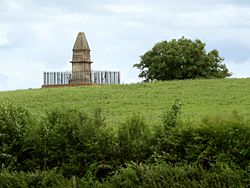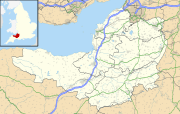Athelney Abbey facts for kids
 |
|
| Monastery information | |
|---|---|
| Order | Benedictine |
| Established | 888 |
| Disestablished | 1540 |
| People | |
| Founder(s) | King Alfred |
| Site | |
| Location | Athelney, Somerset, England |
Athelney Abbey was a special home for monks in Somerset, England. King Alfred started it in 888. It was a place for Benedictine monks to live and pray. The abbey was dedicated to "Our Blessed Saviour, St. Peter, St. Paul, and St. Egelwine".
Contents
The Story of Athelney Abbey
How Athelney Abbey Began
Athelney was once a small island in a swampy area. It was covered with trees and had wild animals. It was hard to reach, mostly by boat. King Alfred hid here from the Danes (Vikings). This is where he decided to build the abbey.
Some people think a smaller religious place might have been there before. King Alfred brought monks from other countries, especially France. The first leader, called an abbot, was John the Old Saxon. The first church was small. King Alfred's original document for the abbey still exists today.
Life at the Abbey
From the 11th century, monks from Glastonbury Abbey tried to take over Athelney. The abbey is also mentioned in the Domesday Book, a famous old record. In 1267, King Henry III allowed the abbey to hold a weekly market.
Athelney Abbey was not a very rich place. In 1321, people were asked to help rebuild the church. The monks even asked King Edward I to let them off a payment they couldn't afford. The last abbot was Robert Hamlyn. He and eight monks gave up the abbey on February 8, 1540. This was part of a big change in England called the Dissolution of the Monasteries.
What Happened After the Abbey Closed
After the abbey closed, Lord Audley bought the land. He planned to build a private house there. The church building was pulled down. However, Audley's plans never happened.
Records show that the land was sold again in 1544 to John Clayton. Then, in 1545, Clayton sold it to John Tynbere. In 1674, more parts of the old abbey were taken down. Workers found the bases of the church pillars and some graves. One grave was 8 feet long!
Today, you can't see any of the original abbey buildings. The site is marked by thumb|King Alfred's Monument at Athelney. King Alfred's Monument. This monument was built in 1801 by Sir John Slade. It helps us remember where the abbey once stood.
Images for kids



